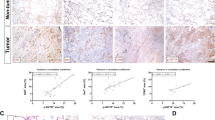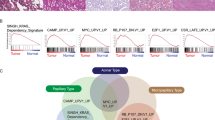Abstract
Recently, we identified a lung adenocarcinoma signature that segregated tumors into three clades distinguished by histological invasiveness. Among the genes differentially expressed was the type II transforming growth factor-β receptor (TGFβRII), which was lower in adenocarcinoma mixed subtype and solid invasive subtype tumors compared with bronchioloalveolar carcinoma. We used a tumor cell invasion system to identify the chemokine CCL5 (RANTES, regulated on activation, normal T-cell expressed and presumably secreted) as a potential downstream mediator of TGF-β signaling important for lung adenocarcinoma invasion. We specifically hypothesized that RANTES is required for lung cancer invasion and progression in TGFβRII-repressed cells. We examined invasion in TGFβRII-deficient cells treated with two inhibitors of RANTES activity, Met-RANTES and a CCR5 receptor-blocking antibody. Both treatments blocked invasion induced by TGFβRII knockdown. In addition, we examined the clinical relevance of the RANTES–CCR5 pathway by establishing an association of RANTES and CCR5 immunostaining with invasion and outcome in human lung adenocarcinoma specimens. Moderate or high expression of both RANTES and CCR5 was associated with an increased risk for death, P=0.014 and 0.002, respectively. In conclusion, our studies indicate RANTES signaling is required for invasion in TGFβRII-deficient cells and suggest a role for CCR5 inhibition in lung adenocarcinoma prevention and treatment.
This is a preview of subscription content, access via your institution
Access options
Subscribe to this journal
Receive 50 print issues and online access
$259.00 per year
only $5.18 per issue
Buy this article
- Purchase on Springer Link
- Instant access to full article PDF
Prices may be subject to local taxes which are calculated during checkout



Similar content being viewed by others
References
Azenshtein E, Luboshits G, Shina S, Neumark E, Shahbazian D, Weil M et al. (2002). The CC chemokine RANTES in breast carcinoma progression: regulation of expression and potential mechanisms of promalignant activity. Cancer Res 62: 1093–1102.
Balkwill F . (2004). Cancer and the chemokine network. Nat Rev Cancer 4: 540–550.
Biswas S, Chytil A, Washington K, Romero-Gallo J, Gorska AE, Wirth PS et al. (2004). Transforming growth factor beta receptor type II inactivation promotes the establishment and progression of colon cancer. Cancer Res 64: 4687–4692.
Borczuk AC, Kim HK, Yegen HA, Friedman RA, Powell CA . (2005). Lung adenocarcinoma global profiling identifies type II transforming growth factor-beta receptor as a repressor of invasiveness. Am J Respir Crit Care Med 172: 729–737.
Borczuk AC, Powell CA . (2007). Expression profiling and lung cancer development. Proc Am Thorac Soc 4: 127–132.
Brambilla E, Travis WD, Colby TV, Corrin B, Shimosato Y . (2001). The new world health organization classification of lung tumours. Eur Respir J 18: 1059–1068.
Culley FJ, Pennycook AM, Tregoning JS, Dodd JS, Walzl G, Wells TN et al. (2006). Role of CCL5 (RANTES) in viral lung disease. J Virol 80: 8151–8157.
Fatkenheuer G, Pozniak AL, Johnson MA, Plettenberg A, Staszewski S, Hoepelman AI et al. (2005). Efficacy of short-term monotherapy with maraviroc, a new CCR5 antagonist, in patients infected with HIV-1. Nat Med 11: 1170–1172.
Forrester E, Chytil A, Bierie B, Aakre M, Gorska AE, Sharif-Afshar AR et al. (2005). Effect of conditional knockout of the type II TGF-beta receptor gene in mammary epithelia on mammary gland development and polyomavirus middle T antigen induced tumor formation and metastasis. Cancer Res 65: 2296–2302.
Gupta GP, Massague J . (2006). Cancer metastasis: building a framework. Cell 127: 679–695.
Gustin JA, Pincheira R, Mayo LD, Ozes ON, Kessler KM, Baerwald MR et al. (2004). Tumor necrosis factor activates CRE-binding protein through a p38 MAPK/MSK1 signaling pathway in endothelial cells. Am J Physiol Cell Physiol 286: C547–C555.
Ijichi H, Chytil A, Gorska AE, Aakre ME, Fujitani Y, Fujitani S et al. (2006). Aggressive pancreatic ductal adenocarcinoma in mice caused by pancreas-specific blockade of transforming growth factor-beta signaling in cooperation with active Kras expression. Genes Dev 20: 3147–3160.
Jang SB, Won J, Kim H, Kim J, Lee KH, Han H et al. (2002). TAK1 mediates lipopolysaccharide-induced RANTES promoter activation in BV-2 microglial cells. Mol Cells 14: 35–42.
Luboshits G, Shina S, Kaplan O, Engelberg S, Nass D, Lifshitz-Mercer B et al. (1999). Elevated expression of the CC chemokine regulated on activation, normal T cell expressed and secreted (RANTES) in advanced breast carcinoma. Cancer Res 59: 4681–4687.
Ma B, Kang MJ, Lee CG, Chapoval S, Liu W, Chen Q et al. (2005). Role of CCR5 in IFN-gamma-induced and cigarette smoke-induced emphysema. J Clin Invest 115: 3460–3472.
Moran CJ, Arenberg DA, Huang CC, Giordano TJ, Thomas DG, Misek DE et al. (2002). RANTES expression is a predictor of survival in stage I lung adenocarcinoma. Clin Cancer Res 8: 3803–3812.
Nakazaki Y, Hase H, Inoue H, Beppu Y, Meng XK, Sakaguchi G et al. (2006). Serial analysis of gene expression in progressing and regressing mouse tumors implicates the involvement of RANTES and TARC in antitumor immune responses. Mol Ther 14: 599–606.
Nissinen R, Leirisalo-Repo M, Tiittanen M, Julkunen H, Hirvonen H, Palosuo T et al. (2003). CCR3, CCR5, interleukin 4, and interferon-gamma expression on synovial and peripheral T cells and monocytes in patients with rheumatoid arthritis. J Rheumatol 30: 1928–1934.
Proudfoot AE, Power CA, Hoogewerf AJ, Montjovent MO, Borlat F, Offord RE et al. (1996). Extension of recombinant human RANTES by the retention of the initiating methionine produces a potent antagonist. J Biol Chem 271: 2599–2603.
Remmelink M, Mijatovic T, Gustin A, Mathieu A, Rombaut K, Kiss R et al. (2005). Identification by means of cDNA microarray analyses of gene expression modifications in squamous non-small cell lung cancers as compared to normal bronchial epithelial tissue. Int J Oncol 26: 247–258.
Sakurai H, Maeshima A, Watanabe S, Suzuki K, Tsuchiya R, Maeshima AM et al. (2004). Grade of stromal invasion in small adenocarcinoma of the lung: histopathological minimal invasion and prognosis. Am J Surg Pathol 28: 198–206.
Schwabe RF, Bataller R, Brenner DA . (2003). Human hepatic stellate cells express CCR5 and RANTES to induce proliferation and migration. Am J Physiol Gastrointest Liver Physiol 285: G949–G958.
Vaday GG, Peehl DM, Kadam PA, Lawrence DM . (2006). Expression of CCL5 (RANTES) and CCR5 in prostate cancer. Prostate 66: 124–134.
van Deventer HW, O’Connor Jr W, Brickey WJ, Aris RM, Ting JP, Serody JS . (2005). C-C chemokine receptor 5 on stromal cells promotes pulmonary metastasis. Cancer Res 65: 3374–3379.
Acknowledgements
This work was supported in part by NIH (1RO1CA120174), American Cancer Society (RSG0524801CNE), Joan's Legacy Foundation and Flight Attendants Medical Research Institute.
We thank Dr Samuel Silverstein and Dr Yens Huseman, Department of Physiology, Columbia University College of Physicians and Surgeons, New York, NY, USA for assistance and advice.
Author information
Authors and Affiliations
Corresponding author
Additional information
Supplementary information accompanies the paper on the Oncogene web site (http://www.nature.com/onc).
Supplementary information
Rights and permissions
About this article
Cite this article
Borczuk, A., Papanikolaou, N., Toonkel, R. et al. Lung adenocarcinoma invasion in TGFβRII-deficient cells is mediated by CCL5/RANTES. Oncogene 27, 557–564 (2008). https://doi.org/10.1038/sj.onc.1210662
Received:
Revised:
Accepted:
Published:
Issue Date:
DOI: https://doi.org/10.1038/sj.onc.1210662
Keywords
This article is cited by
-
Bone marrow-derived mesenchymal stem cells promote colorectal cancer progression via CCR5
Cell Death & Disease (2019)
-
Cancer overdiagnosis: a biological challenge and clinical dilemma
Nature Reviews Cancer (2019)
-
Cancer-FOXP3 directly activated CCL5 to recruit FOXP3+Treg cells in pancreatic ductal adenocarcinoma
Oncogene (2017)
-
Nuclear heparanase-1 activity suppresses melanoma progression via its DNA-binding affinity
Oncogene (2015)
-
Plasma RANTES, IL-10, and IL-8 levels in non–small-cell lung cancer patients treated with EGFR-TKIs
BMC Research Notes (2013)



